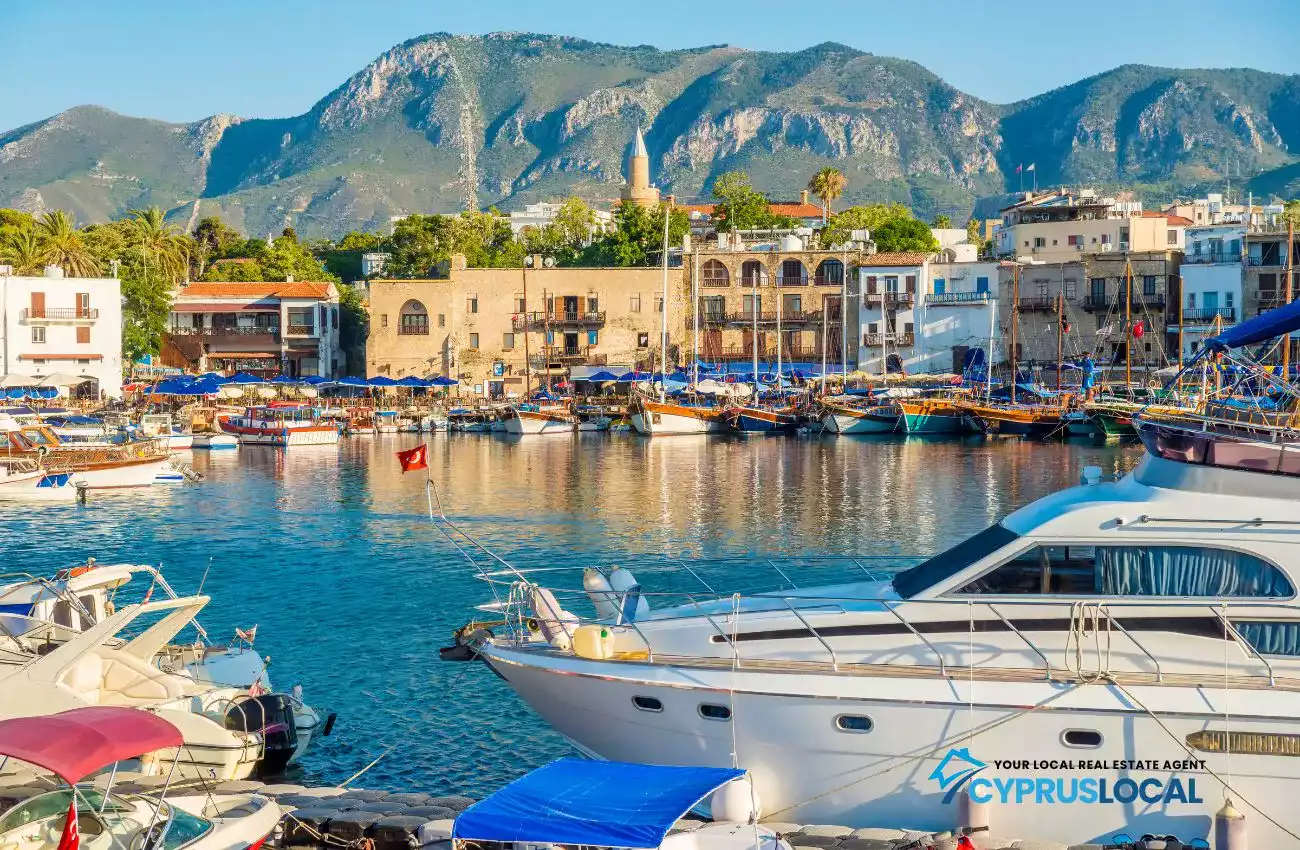Girne (Kyrenia in Greek), located on the northern coast of Cyprus, is one of the island’s most historically rich and architecturally vibrant cities. With its breathtaking harbor, stunning mountains, and a history that stretches back millennia, Girne is not only a popular destination for tourists but also a living testament to the diverse cultures and civilizations that have left their mark on Cyprus. From the ancient Greeks and Romans to the Byzantines, Lusignans, Venetians, Ottomans, and British, each era has contributed to the rich tapestry of Girne’s history and architecture.
The Ancient Foundations of Girne
Girne’s origins date back to ancient times, with its history stretching as far back as the 10th century BC, when the city was likely founded by Achaean settlers from Greece. These settlers established a coastal city that became a strategic trading port due to its location along important Mediterranean maritime routes. The ancient harbor, still the heart of modern Girne, was central to the city’s early economic prosperity, facilitating trade between Cyprus and mainland Greece, Egypt, and Asia Minor.
In antiquity, Girne was closely connected to the Kingdom of Salamis, located on the eastern part of the island, which was the dominant city-state in Cyprus. Under Salamis’ influence, Girne flourished, developing into a thriving port town. Archaeological evidence from the area points to strong Hellenistic and Roman influences, with remnants of ancient walls, pottery, and coins found in and around the city.
Byzantine Era: The Rise of Girne Castle
The city’s significance continued into the Byzantine period (330-1191 AD), which saw a number of defensive structures built to protect it from Arab raids that plagued the Mediterranean during this time. The most prominent of these is the Girne Castle, which was constructed to protect the harbor and the town from seafaring invaders. Initially a small Byzantine fortress, the castle’s early structure was relatively modest compared to its later expansions. It served as a key defensive point during the Byzantine-Arab wars, a period of frequent invasions from the sea.
The original Girne Castle featured typical Byzantine defensive architecture: thick stone walls, lookout towers, and a strategic location right by the sea, enabling quick access to the harbor while providing formidable protection. The castle underwent several renovations and expansions over the centuries, with each ruling power leaving its own mark.
Lusignan and Venetian Periods: Gothic Flourishes
In 1191, the rule of Cyprus changed hands when Richard the Lionheart of England captured the island during the Third Crusade. Shortly after, the island was sold to the Lusignan dynasty, a French noble family that established the Kingdom of Cyprus and ruled the island for nearly three centuries (1192-1489). Under the Lusignan kings, Girne and its castle saw a significant transformation.
The Lusignans expanded Girne Castle, adding a number of architectural features typical of Gothic architecture, which was prevalent in Europe during the medieval period. The Gothic influence is particularly visible in the pointed arches, ribbed vaults, and tall windows of the castle’s interior spaces. The Lusignans also reinforced the castle’s defenses, turning it into a formidable stronghold capable of withstanding sieges. During this period, Girne Castle became a symbol of the Lusignan rule in the region and a crucial part of the island’s defense network.
In 1489, Cyprus fell under the control of the Venetians, who were masters of maritime defense and further strengthened Girne’s fortifications. The Venetians transformed the castle into an even more robust fortress, capable of defending against the rising threat of the Ottoman Empire. They added thick bastions to the castle walls and improved the harbor’s defenses, ensuring that Girne remained a strategic naval base. The Venetians’ architectural contributions are visible in the castle’s angled bastions, designed to deflect cannon fire, and the additional outer fortifications.
Ottoman Period: A New Cultural Influence
In 1571, after a long and bloody siege, Cyprus was conquered by the Ottoman Empire, and Girne, along with the rest of the island, came under Ottoman rule. This conquest marked a significant cultural and architectural shift in the city. While the Ottomans preserved many of the existing structures, including Girne Castle, they introduced their own Islamic architectural elements into the city.
One of the most notable Ottoman contributions is the Ağa Cafer Pasha Mosque, which was built in the 1580s. This mosque, with its traditional Ottoman architectural style, features a simple yet elegant design, with a square prayer hall topped by a single dome and a slender minaret. The mosque still stands today and serves as a reminder of the Ottoman influence on the city’s culture and architecture.
Additionally, the Ottomans converted many of the existing Gothic churches into mosques, reflecting the changing religious landscape of Cyprus. St. Andrew’s Church, originally built during the Lusignan period, was one such structure. The Ottomans also constructed hammams (Turkish baths), fountains, and other public buildings that contributed to the transformation of Girne into a bustling Ottoman town.
British Rule: A Modern Era Begins
In 1878, Cyprus was leased to the British Empire, although it remained officially part of the Ottoman Empire until 1914 when it was formally annexed by Britain. Under British rule, Girne experienced modernization, with the construction of new roads, public buildings, and infrastructure. However, the British were careful to preserve much of the island’s historic architecture, and many of the ancient and medieval structures in Girne survived this period of rapid development.
The British also left their own architectural legacy in Girne, including administrative buildings designed in the colonial style. These buildings, often characterized by their symmetry, columns, and verandas, reflected the British architectural preferences of the time and introduced a new layer of architectural diversity to the city.
Girne’s Modern Architecture
Today, Girne is a thriving city that blends its rich historical past with modern developments. In recent decades, the city has seen the construction of luxury hotels, villas, and resorts, particularly along its beautiful coastline, catering to the growing tourism industry. Modern Girne has managed to maintain its historical charm while embracing contemporary architecture, particularly in the areas of residential and commercial development.
The Girne Harbor, one of the most picturesque spots in the city, remains at the heart of Girne’s architectural beauty. Surrounded by old stone buildings, many of which have been converted into restaurants, cafes, and boutique hotels, the harbor is a vibrant blend of old and new. The iconic Girne Castle still stands sentinel over the harbor, a constant reminder of the city’s layered history.
Preserving Girne’s Heritage
Efforts to preserve Girne’s historical architecture have been ongoing, as both the Cypriot government and local organizations recognize the importance of maintaining the city’s cultural and historical identity. Many of the city’s ancient and medieval structures have been restored and are open to the public, offering visitors a chance to step back in time and experience the history of this remarkable city firsthand.
Girne’s Old Town, with its narrow, winding streets and traditional stone houses, has also been the focus of preservation efforts. These houses, many of which date back to the Ottoman period, are built with local materials and feature characteristic wooden balconies and shuttered windows. The preservation of these buildings ensures that the unique architectural character of Girne is not lost amidst the city’s modern growth.
Conclusion
Girne is a city where history and architecture are deeply intertwined. From its ancient origins as a bustling port town to its time under Byzantine, Lusignan, Venetian, Ottoman, and British rule, each era has left its mark on the city’s landscape. The result is a city that is a living museum of Cypriot history, where Gothic cathedrals stand alongside Ottoman mosques and Venetian fortifications. Today, Girne continues to evolve, blending the old with the new, while preserving the architectural and cultural heritage that makes it one of the most fascinating cities in Cyprus.





